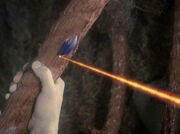m (+pic) |
m (Robot: Automated text replacement (-Image: +File:) !!wikia-credits fix!!) |
||
| (10 intermediate revisions by 8 users not shown) | |||
| Line 1: | Line 1: | ||
| − | [[ |
+ | [[File:Surata_IV_thorn.jpg|thumb|[[Data]] and [[Geordi La Forge|La Forge]] carefully extract a thorn from one of the large predatory vines of [[Surata IV]] using a phaser, in order to collect Surata microbes]] |
| − | '''Surata microbes''' |
+ | '''Surata IV microbes''' were [[microorganism]]s contained in thorns on the large [[Surata IV predatory vine|predatory vines]] of [[Surata IV]]. These microbes possess elements of both a [[bacteria]] and a [[virus]], and are designed to infect the [[nervous system]] of warm-blooded animals in order to enrich the soil surrounding the vines with the decaying remains following death. |
| − | In [[2365]], [[Commander]] [[William Riker]] was attacked by one of the vines. |
+ | In [[2365]], [[Commander]] [[William T. Riker]] was attacked by one of the vines. The microbes then attached themselves to the great [[sciatic nerve]] and began multiplying, fusing themselves to the nerves at a molecular level. Conventional [[surgery]] and the [[transporter]]'s [[biofilter]] were unable to remove the microbes, which were causing no damage but were impeding neural functions. This led to eventual paralysis and brain infection. The growth rate of the microbes doubled when exposed to [[endorphin]]s released by erotic dreams and decreased significantly when other chemicals were released by stimulated feelings of survival. ({{TNG|Shades of Gray}}) |
| − | [[Category: |
+ | [[Category:Microorganisms]] |
| + | [[fr:Microbe de Surata]] |
||
Revision as of 00:47, 18 March 2010

Data and La Forge carefully extract a thorn from one of the large predatory vines of Surata IV using a phaser, in order to collect Surata microbes
Surata IV microbes were microorganisms contained in thorns on the large predatory vines of Surata IV. These microbes possess elements of both a bacteria and a virus, and are designed to infect the nervous system of warm-blooded animals in order to enrich the soil surrounding the vines with the decaying remains following death.
In 2365, Commander William T. Riker was attacked by one of the vines. The microbes then attached themselves to the great sciatic nerve and began multiplying, fusing themselves to the nerves at a molecular level. Conventional surgery and the transporter's biofilter were unable to remove the microbes, which were causing no damage but were impeding neural functions. This led to eventual paralysis and brain infection. The growth rate of the microbes doubled when exposed to endorphins released by erotic dreams and decreased significantly when other chemicals were released by stimulated feelings of survival. (TNG: "Shades of Gray")
